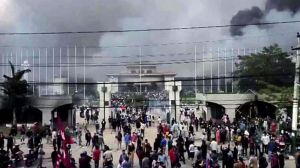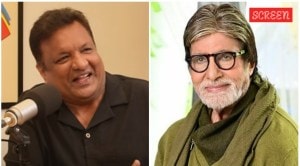Stay updated with the latest - Click here to follow us on Instagram
Skyscraper to floating city: Students offer solutions to urban space crunch
Believing that even the most glamorous and dynamic cities have their share of problems,students of the premier Veer Jijamata Technological Institute in Matunga have sought to find engineering solutions to common and long-standing problems plaguing cities,including Mumbai.
Believing that even the most glamorous and dynamic cities have their share of problems,students of the premier Veer Jijamata Technological Institute (VJTI) in Matunga have sought to find engineering solutions to common and long-standing problems plaguing cities,including Mumbai.
Their unique solutions have been compiled in an exhibition that is a part of Technovanza 2011,which will exhibit replicas of modern cities as envisaged by the students.
Among the innovative ideas are a skyscraper accommodating an entire city and a floating city built in the sea. A group of engineering students from VJTI have been working to create models of a skyscraper city and a floating city,which would be exhibited at Technovanza 2011 from February 4 to 6.
Imagine you work on the first floor of a building and reside on the fifth, said Harshad Bhoir,a second-year student of civil engineering.
Called the scrapper city,it is designed to overcome the problem of congestion of buildings on a widespread area and simply aims to condense the entire city into a single place.
Bhoir says,The idea is to build a skyscraper that is self-sufficient and includes all the basic amenities desired by people in a city. The structure is huge enough to accommodate the population of more than 50,000 people. It will have commercial and residential buildings,an entertainment hub,hospitals,educational institutions,security and transport. We have also incorporated special provisions of fighting fire hazards by having safe rooms at alternate floors,which would be 100 per cent fire-proof. We would use elevators with seating arrangements as transport system in the city.
The building is designed to be around 1,000 metres high (higher than Burj Khalifa,Dubai),and will have 12 decks. Besides,the building is also designed to be eco-friendly as the students have incorporated facilities such as biogas plants,wind turbines,rain water harvesting,use of solar panels etc.
Not only this,the city will also have greenhouses but without using soil as students are working on a concept called hydroponics. This would reduce the dead weights that are seen in case of a regular greenhouse that uses soil, Bhoir added.
Another group of students have created a model of city floating on the sea. However,the city is not just designed to float on the sea but it also moves. Amit Rai,another civil engineering student said: The floating city is self-sustainable and uses conventional sources to produce energy such as solar energy,wind energy and would even have ocean thermal energy conservation (OTEC) plants. It has residential areas,multilevel farming areas,educational institutes,hotels,parks,industries and elevated roads. The city is designed to accommodate a population of one lakh.
Floating city is made up of several hexagons which are made up of marine concrete and steel; these are joined together by universal hinges. The city is kept stable with the help of gyroscopes and dampers. Elevated roads are provided since movement of the hexagons will not affect the roads.
Apart from solar taxis,there are metro trains for transportation. The floating city will connect the people to the other city with the help of ferry and boats. We are now working on the feasibility of the project as it is going to be very costly as far as making floating cities is concerned, says Rai.
Raunak Dhalawat,a student of VJTI and member of the organising team of Technovanza 2011,said: Out theme this year is innovations,so we will be exhibiting these innovative replica of cities. The cities are expected to resolve the problems of space constraint. The two models of the cities will be exhibited at the Technovanza. Apart from this,we will also exhibit a model of a harbour with three breakwaters in a pentagonal shape.








